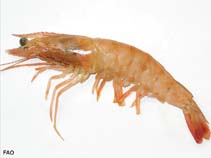Penaeus duorarum Burkenroad, 1939
Pink shrimp
رده بندی / Names اسامي عام | مترادف | CoL | ITIS | WoRMS
Malacostraca | Decapoda | Penaeidae
Environment: milieu / climate zone / تغييرات عمق / distribution range بوم شناسي
; تغييرات عمق 0 - 330 m (مرجع 356), usually 11 - 36 m (مرجع 8). Tropical, preferred 24°C (مرجع 107945); 39°N - 8°N, 98°W - 60°W
Distribution كشورها | مناطق سازمان خوار و بار جهاني (FAO) | Ecosystems | ظهور | معرفي
Western Atlantic and the Caribbean.
Length at first maturity / Size / Weight / سن
بلوغ: Lm 2.2, range 9 - ? cm Max length : 26.9 cm TL جنس نر / بدون خواص جنسي; (مرجع 8); 28 cm TL (female); بيشينه سن گزارش شده: 2.00 سال ها (مرجع 108798)
Life cycle and mating behavior بلوغ | تولید مثل | تخم ریزی | Eggs | Fecundity | Larvae
مآخذ اصلی
مراجع | هماهنگ كننده | همكاران
Holthuis, L.B. 1980 FAO Species Catalogue. Vol. 1. Shrimps and prawns of the world. An annotated catalogue of species of interest to fisheries. FAO Fish. Synop. 125(1):271 p. Rome: FAO. (مرجع 8)
وضعيت در فهرست قرمز IUCN
(مرجع 130435: Version 2025-1)
وضعيت از نظر سايتس (مرجع 108899)
CMS (مرجع 116361)
خطر برای انسان ها
استفاده انسانی
ماهي گيري – شيلات: تجاري; طعمه: usually
FAO - ماهي گيري – شيلات: landings, نمايه گونه | FishSource | Sea Around Us
ابزارها
اطلاعات بيشتر
منابع اينترنتي
BHL | BOLD Systems | CISTI | DiscoverLife | FAO(ماهي گيري – شيلات: نمايه گونه; publication : search) | Fishipedia | GenBank (ژنوم, نوکلئوتيد) | GloBI | 1 GoMexSI (interaction data) | Google Books | Google Scholar | Google | PubMed | Tree of Life | Wikipedia (برو, جستجو) | Zoological Record



